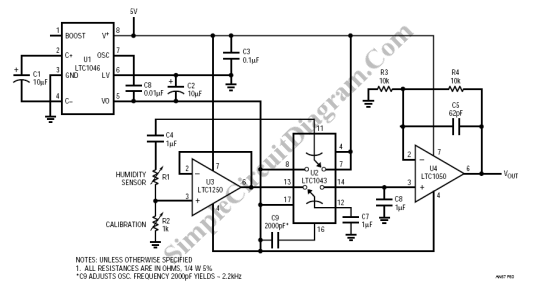Humidity Sensor
Introduction
Humidity is the amount of water vapor in the air, expressed as a percentage of the maximum amount that the air could hold at the given temperature. To build a humidity sensor can be difficult because of their wide dynamic range and sensor’s drive requirement. But we can build the humidity sensor with reasonable accuracy within the chosen range by customize the circuit. To customize the circuit by carefully selecting the devices that comprise the analog front end. how to design analog signal conditioner for Phys-Chem Scientific Corp.1 model EMD-200o humidity sensor described by the following description
Design Requirements
we want to build a humidity sensor with small size and low cost but has reasonable accuracy. so we choose The Phys-Chem sensor. This type is an accurate resistance-type relative humidity (RH). this sensor has the system utilizing that would be easily maintainable, because we can replace sensor without recalibration, as well the sensor has defined stable response curve. High precision analog front end with only few calibration tweaks are required by sensor to do sensor’s high performance,but must be works with 5 volts supply and low cost. For the excitation of this sensor, it requires a sine or square wave without DC component. As well, this sensor has very wide range of dynamic reactance (700 Ohm to 20MOhm). To obtain full RH range performance, we must think about This wide dynamic range (about 90 dB).

The Circuit Design
in this circuit we use the feature of zero drift of operational amplifiers LTC1250 and LTC1050. A precision instrumentation switched capacitor block LTC1043 is also used in this circuit. This circuit will maintain A microvolts levels of DC accuracy,so we can reduce the cost because we don’t need a true RMS-to-DC or log converter beside that that will be unstable as the temperature changes. In this circuit LTC1046 will convert the 5V supply into -5V supply. So we need only a single 5 volt supply. There is a negative supply in this circuit that is used by U2, U3, and U4.
The U2A provides the excitation for the sensor, part of LTC1043 switched capacitor building block. This excitation is an AC square wave that swing between -5 and 5+ volts with approximately 2.4 kHz, which is one-half of the auto zero rate of U3. He deviation from the Phys Chem response curve taken at 5 KHz,that is can considered in insignificant.Variable resistor R2 provides the full scale setting. We must set the R2 at 700 Ohm will result in 2:1 voltage divider, because the resistance of the sensor is 700 Ohm at approximately 90% RH. The gain,that generated by This voltage divider will in overall gain of one if combined with the U4 gain (gain=2). U3 must be included, in order to function properly,otherwise, a voltage divider will formed by C4 and C7 , that depends on the RH sensor resistance. U3 is a precision auto zero operational amplifier with auto zero frequency about 4.75 kHz. The “lower” switch U2B samples the U3 output.then this sample provided for the U4 input. U4 is set to provide a gain of 2.
To digitize the output of U4 is easy.this sensor’s sensitivity depends on the resolution of the converter. The dry (low RH) end of the scale is dependent on the A/D resolution. However the full-scale output (approximately 90% humidity) is essentially independent of the number of bits in the ADC. As an example, a 12-bit DAC will process humidity signals that translate to approximately 20% RH, since the voltage output at this humidity is approximately 2.3mV, while 0.5LSB is 1.2mV. To read lower RH down to 10%, converting 350uV signals would require a 16-bit converter. A 16 bit ADC is expensive, so it is much more economical to use a 2-channel 12-bit converter that changes ranges somewhere in the humidity range. [Circuit’s schematic diagram source: Linear Technology Application Notes]